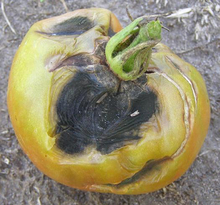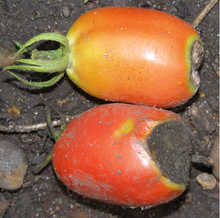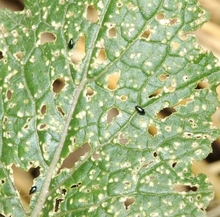Quick facts
- This page highlights non-chemical practices to prevent or manage common insect and disease problems of tomatoes.
- For more detailed information follow the links in each section.
- Click on an image to enlarge it.
- See Growing healthy vegetables for more detailed information on how to keep your garden disease and pest free.
Preventing leaf spot and fruit rot diseases
- Plant tomatoes where no tomatoes, potatoes, peppers or eggplants have been for the past 3-4 years.
- Keep tomato leaves as dry as possible.
- Water with drip irrigation or a soaker hose.
- Water in the morning so leaves dry quickly in the sun.
- Stake or cage plants.
- Space plants so that air flows between them.
- Mulch all exposed soil with plastic or organic mulch.
- Scout tomato plants once a week.
- Look at lower leaves for leaf spots.
- Remove infected leaves and rotten fruit from the garden.
- Remove or bury tomato plants at the end of the season.
More information on early blight of tomato.
More information on bacterial spot of tomato.
Blossom end rot
- Irrigate to keep soil moisture even.
- Mulch the soil to maintain soil moisture.
- Don't use too much fertilizer, especially nitrogen.
- Avoid damaging roots. Don't dig or cultivate for weeds close to the plant.
More information on blossom end rot.
Viral diseases
- Remove and destroy infected plants.
- Remove weeds in the field.
- Clean tools and hands after touching infected plants.
More information on tomato viruses.
Cutworms
- Remove weeds and plant residue.
- Till garden before planting.
- Place cardboard collars or aluminum foil around plant stems when planting transplants.
More information on cutworms.
Flea beetles
- Plant as late as possible.
- Cover plants with a row cover (light weight fabric — remove when tomatoes are flowering).
- Plant a trap crop, like radish, before tomatoes.
More information on flea beetles.
Reviewed in 2019














